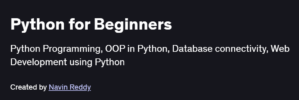What will you learn in Hexagonal Software Architecture for Web Applications Course
Grasp the principles of Hexagonal (Ports & Adapters) architecture and its benefits over layered designs
Isolate domain logic behind well-defined ports, enabling independent testing and replacement of external dependencies
Implement inbound adapters (e.g., REST controllers, CLI) and outbound adapters (e.g., database, messaging) in web apps
Apply Dependency Inversion to decouple application core from frameworks and infrastructure concerns
Integrate testing strategies: unit tests on domain, integration tests on adapters, and end-to-end validation
Program Overview
Module 1: Introduction to Hexagonal Architecture
⏳ 1 week
Topics: Evolution of software architecture, limitations of traditional layers, hexagon model overview
Hands-on: Sketch the hexagon diagram for a sample “To-Do” application
Module 2: Defining the Domain & Ports
⏳ 1 week
Topics: Core domain modeling, boundary interfaces (ports), use-case definitions
Hands-on: Write domain entities and port interfaces for task creation and querying
Module 3: Building Inbound Adapters
⏳ 1 week
Topics: HTTP controllers, CLI interfaces, WebSocket entry points as inbound adapters
Hands-on: Implement a REST adapter using a lightweight web framework to expose port functionality
Module 4: Developing Outbound Adapters
⏳ 1 week
Topics: Persistence adapters (SQL, NoSQL), messaging adapters (Kafka, RabbitMQ), external API clients
Hands-on: Create a database adapter for tasks using an ORM and configure it behind the repository port
Module 5: Wiring the Application & Configuration
⏳ 1 week
Topics: Dependency injection, wiring ports to adapters, environment-based configuration
Hands-on: Bootstrap the application by assembling the hexagon in a main entry-point
Module 6: Testing Strategies
⏳ 1 week
Topics: Unit testing the domain (mocking ports), adapter integration tests, end-to-end tests
Hands-on: Write tests for domain logic with a fake adapter and integration tests against an in-memory database
Module 7: Error Handling & Cross-Cutting Concerns
⏳ 1 week
Topics: Exception translation, logging, metrics, security adapter patterns
Hands-on: Implement a global error handler adapter and integrate logging via an outbound port
Module 8: Deployment & Evolution
⏳ 1 week
Topics: Containerization of adapters, versioning ports for backward compatibility, gradual adapter replacement
Hands-on: Containerize the web and database adapters with Docker, and demonstrate swapping the DB adapter
Get certificate
Job Outlook
Knowledge of Hexagonal Architecture is highly valued for senior backend roles, architecture reviews, and greenfield projects
Roles include Software Architect, Senior Backend Engineer, and Technical Lead
Salaries typically range from $110,000 to $170,000+ depending on region and seniority
Mastery of clean, decoupled architectures boosts maintainability, testability, and team onboarding efficiency
Specification: Hexagonal Software Architecture for Web Applications
|
FAQs
- Basic understanding of web application development is recommended but not strictly required.
- The course introduces hexagonal architecture concepts step by step.
- Beginners may need additional resources to understand architecture patterns.
- Hands-on examples demonstrate how to structure applications effectively.
- By the end, learners can apply hexagonal principles to build maintainable and scalable web applications.
- Yes, the course focuses on decoupling core logic from external systems like databases and APIs.
- Learners practice defining ports and adapters for different application layers.
- Techniques for maintaining independence between business logic and infrastructure are included.
- Hands-on examples illustrate organizing code for testability and maintainability.
- Advanced layering strategies may require further practice and real-world experience.
- Yes, the course emphasizes designing applications for easier testing and maintenance.
- Learners practice creating isolated units of code that can be tested independently.
- Principles like dependency inversion and interface segregation are applied.
- Hands-on examples show refactoring monolithic code into testable modules.
- Advanced testing strategies may require additional tools or study.
- Yes, the course covers integrating databases, APIs, and external services via adapters.
- Learners practice designing flexible interfaces to minimize coupling.
- Techniques ensure external changes have minimal impact on core application logic.
- Hands-on exercises demonstrate connecting to real-world services while preserving architecture integrity.
- Advanced integrations may require further study of external system APIs or protocols.
- Yes, the course provides guidance on applying hexagonal principles to existing projects.
- Learners practice identifying core logic, creating ports/adapters, and decoupling components.
- Refactoring improves modularity, testability, and scalability of applications.
- Hands-on exercises demonstrate incremental adoption of hexagonal patterns.
- Large-scale refactoring may require additional planning and real-world experience.





